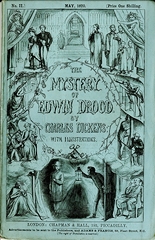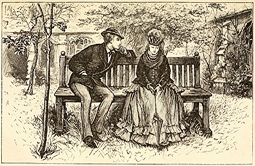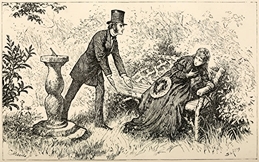Tue 8 Aug 2023
A 1001 Midnights Review: CHARLES DICKENS – The Mystery of Edwin Drood.
Posted by Steve under 1001 Midnights , Reviews[4] Comments
by Mark Johnson

CHARLES DICKENS – The Mystery of Edwin Drood. Published posthumously in 1870. Only six of the twelve projected parts had been completed by the time of Dickens’s death. First published in the US as The Mystery of Edwin Drood, and Some Uncollected Pieces (Fields, Osgood, 1870).
Charles Dickens turned to the pure mystery near the end of his life, and left us, in The Mystery of Edwin Drood, one of the most compelling of all literary puzzles.
Edwin Drood and Rosa Bud, both orphans, were betrothed as children by their parents. Now, as they approach their majority, this arrangement has poisoned the love between them. Edwin is fond of his uncle, John Jasper, the music director of the town cathedral, and his uncle appears fond of Edwin. But Jasper has fallen in love with Rosa, who despises him, and he is consumed by jealousy of his nephew.
Another youth, Neville Landless, admires Rosa and, goaded by Jasper, Drood and Landless quarrel. Subsequently, Edwin and Rosa agree that their marriage would not work and call off the engagement. But before they can announce their decision, Edwin disappears-apparently the victim of murder.

Evidence points to Landless, but there is no case against him because no body has been found. Landless flees in disgrace to London. Rosa, afraid of Jasper, also goes to London. A new character on the scene, known as Mr. Datchery but apparently someone else in disguise, begins dogging Jasper’s footsteps.
At this point, halfway through the projected novel, Dickens died. He left evidence that Jasper was Drood’s killer-but also hinted that there had been no murder. An early working title for the novel was Edwin Drood in Hiding, and some have speculated that Jasper failed in his murder attempt and that Datchery is really the vengeful Drood. There have been many other theories about the novel’s conclusion. One, championed by the late Edmund Wilson (who hated mysteries but loved Dickens), is that Jasper was a devotee of the Indian Cult of Thugs, and that he murdered Drood as a required ritual act. Dickens’s remaining notes are ambiguous, however, and he had promised that the ending would be a great surprise, even to his friends.

Dickens was a significant figure in the development of the mystery novel long before Edwin Drood. In 1828, when Dickens was seventeen, Robert Peel launched the modern London police force. The young writer was fascinated by the new profession, and in 1850 his magazine, Household Words, published four articles on police work, spawning considerable public interest in crime fighting. In Bleak House (1853), Dickens introduced the intrepid Inspector Bucket, a sort of nineteenth-century Columbo, who was the first fictional English police detective. Dickens was deeply influenced by his friend Wilkie Collins, whose classic novel The Moonstone was published in Dickens’ periodical All the Year Round in 1868.
———
Reprinted with permission from 1001 Midnights, edited by Bill Pronzini & Marcia Muller and published by The Battered Silicon Dispatch Box, 2007. Copyright © 1986, 2007 by the Pronzini-Muller Family Trust.
August 8th, 2023 at 4:00 pm
The best “completions” I know are by Leon Garfield, an English writer best known for his very Dickensian children’s stories, and Carlo Fruttero and Franco Lucentini’s The D Case, Or The Truth About The Mystery Of Edwin Drood, where Dickens’s chapters are interrupted by a conference of famous fictional detectives trying to solve the case.
Spoiler for the unwritten section: it’s been suggested that the “surprise ending” is the revelation that Jasper – an opium addict – murdered his nephew under the influence of opium but was wholly unaware of it and is sincerely eager to solve the mystery. Eventually he does so…
August 8th, 2023 at 7:57 pm
I agree about both the two alternatives Roger refers to with some preference for Garfield simply for his ability to come close to the Dickensian voice. The other is more interesting as literary gamesmanship than novel.
I’ve always found the opium inspired amnesia a bit too close to Collin’s MOONSTONE for Dickens to have thought it truly original and my suspicion is that Dickens might well have planned to reveal Jasper murdered the wrong man under influence of the opium and Drood fled, disguised himself as Datcherly, and was essentially haunting Jasper until he broke and revealed himself.
Dickens did love his happy endings when possible and it seems unlikely he would have left Rosa hanging, though, of course, there is always Little Nell’s fate to take into account.
Ironically the greatest mystery is simply that we can never solve the mystery definitively. Whatever solution we put forth we can never know if it is Dickens solution.
Wilson’s Thugee cult solution does have some weight because of the Indian business in MOONSTONE, which must have been on Dickens mind.
Just for the hell of it I’ll propose an ending I can almost guarantee Dickens did not have in mind, what I call the noir, Drood ending. Rosa in a fit of anger at Edwin ending their engagement murdered Edwin not knowing he had discovered she was his sister and was seen by Jasper who then blackmailed her, she fled to London to escape, but unknown to her their father, Datcherly learned the details from Latchless in London and is trying to get to the bottom of the mystery of who murdered Edwin, if Edwin is actually dead and not hiding ashamed to hurt Rosa by revealing the truth.
August 8th, 2023 at 8:34 pm
The book was adapted into a musical in 1985, and had a good run on Broadway.
And when they got to the part of the story where it just stops — they stopped the show, and let the audience vote on which character was the murderer. Whichever one got the most applause, the play resumed with a specific finale showing that particular killer.
It won several Tony awards, including Best Musical. Don’t think it was ever officially filmed or videoed, but there is a cast recording of the score.
The adapter / composer was Rupert Holmes who himself has written a few mystery novels.
August 13th, 2023 at 2:51 am
Charles Dickens has written my favorite ghost story: ‘The Signal-Man’.
I went to London once as a student, to visit his house and view famous locales still standing which appear in his works
I haven’t read ‘Drood’ only because all his works are so addicting, I’ve had to curtail my habit like a weak-willed junkie.